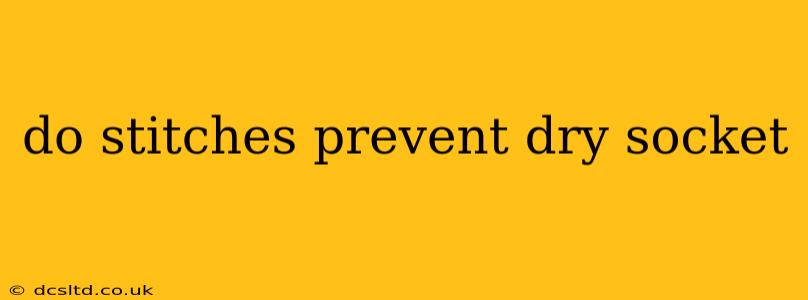Dry socket, or alveolar osteitis, is a painful complication that can occur after a tooth extraction. It happens when the blood clot that normally forms in the extraction site becomes dislodged or dissolves prematurely, exposing the underlying bone and nerve endings. While stitches aren't a guaranteed preventative measure, they certainly play a role in minimizing the risk. Let's delve into the connection between stitches and dry socket.
What are stitches (sutures) used for after a tooth extraction?
Stitches, or sutures, are used after a tooth extraction for several crucial reasons:
- Control Bleeding: They help to constrict blood vessels, reducing bleeding and promoting clot formation. A stable blood clot is the first line of defense against dry socket.
- Wound Closure: Stitches help close the extraction site, keeping the edges of the gum tissue together. This creates a more protected environment for the blood clot to form and remain undisturbed.
- Tissue Approximation: This helps to ensure proper healing and minimizes the risk of infection. A well-approximated wound heals more quickly and efficiently.
- Comfort: Stitches can contribute to patient comfort by reducing post-operative swelling and pain.
Do stitches completely prevent dry socket?
No, stitches alone do not guarantee that you won't develop dry socket. While they significantly reduce the risk, other factors contribute to its development. These include:
- Patient Factors: Smoking, poor oral hygiene, and certain medical conditions can increase the risk of dry socket, irrespective of whether stitches were used.
- Type of Extraction: Complex extractions, particularly those involving impacted teeth, are more prone to dry socket, even with meticulous suturing.
- Surgical Technique: The surgeon's skill and technique during the extraction significantly impact the risk. Careful removal of the tooth and gentle handling of the tissues are crucial for optimal healing.
- Infection: Infection can disrupt clot formation and lead to dry socket, regardless of the presence of stitches.
What other factors reduce the risk of dry socket?
Besides stitches, several other factors can help minimize the risk:
- Following Post-Operative Instructions Carefully: This includes avoiding smoking, rinsing aggressively, using a straw, and consuming excessively hot foods or drinks. These actions can dislodge the blood clot.
- Maintaining Good Oral Hygiene: Gentle brushing and flossing around the extraction site (once healing allows) helps keep the area clean and promotes healing.
- Taking Prescribed Medications: Pain relievers and antibiotics (if prescribed) help manage pain and prevent infection.
- Regular Follow-up Appointments: These allow your dentist or oral surgeon to monitor the healing process and address any potential complications early on.
How do stitches contribute to healing and prevent dry socket?
Stitches primarily help prevent dry socket by:
- Creating a stable environment: They hold the gum tissue together, creating a contained space for the blood clot to form and remain undisturbed.
- Promoting clot formation: By controlling bleeding, stitches help ensure the formation of a strong, stable blood clot essential for healing.
- Reducing post-operative trauma: Minimizing trauma during the extraction and post-operative care reduces the chances of dislodging the clot.
Are there cases where stitches might not be used?
In some instances, simple extractions with minimal tissue trauma may not require stitches. Your dentist will assess the individual circumstances and determine if stitches are necessary.
In conclusion:
While stitches significantly reduce the risk of dry socket by promoting clot formation and protecting the extraction site, they are not a foolproof preventative measure. Following post-operative instructions, maintaining good oral hygiene, and adhering to your dentist's recommendations are crucial for optimal healing and reducing the risk of complications like dry socket. If you experience severe pain, persistent bleeding, or any other concerning symptoms after a tooth extraction, contact your dentist immediately.
